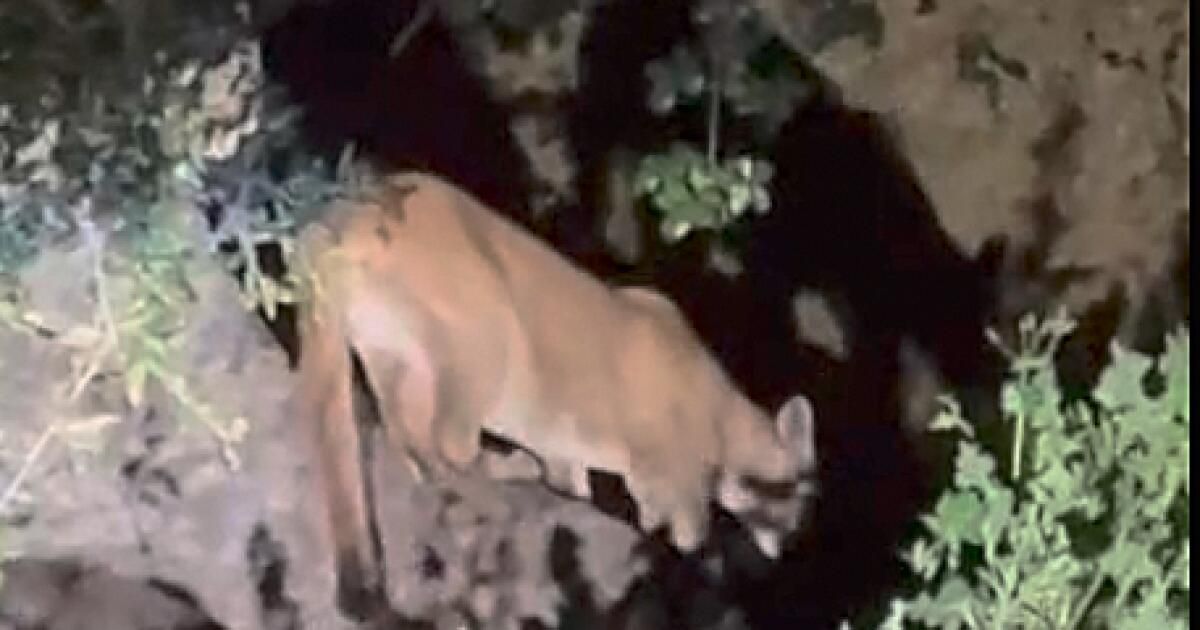There was no doubt about it. The burly, hairy blonde animal on a tree trunk illuminated by car headlights in a parking lot east of Barham Boulevard at the edge of Griffith Park last week was a mountain lion.
Oh really? In Los Angeles, the beloved mountain lion named P-22 had lived for a decade in Griffith Park. But he was an aberration. It was surprising that he got there in the first place, probably crossing dangerous highways to get to the park, narrow by lion standards, where he easily found prey like deer and just as easily avoided the people who flocked there to have fun.
He was captured and euthanized in late 2022 due to serious illness and injuries.
But here was the video, filmed by a resident of the adjacent apartment complex. It was as if the camera had captured the ghost of the most famous cat in Los Angeles.
The only thing I could think was: Don't move! Stay! Better yet, get out of the parking lot! One of the main causes of death for urban pumas is being hit by a vehicle. And in the video he is also seen walking unsteadily along the grassy side of the parking spaces. (A wildlife biologist says the cat in the video is most likely a male, so I choose “he.”)
It would be safer for the cat to hide among the trees and grassy space of the park and wait for National Park Service biologists to find and tranquilize it to take biological samples for genetic testing and place a GPS collar on its neck. so we can roam remotely with him.
And they are definitely interested in adding this cat to the study of cougars in the Santa Monica Mountains (including Griffith Park), Simi Hills and the Santa Susana Mountains that the agency has been conducting for more than two decades.
Jeff Sikich, a biologist on the study, says the video suggests the cat is a young adult and probably a male based on the breadth of the shoulders, musculature and a glimpse of the genitals. It's the first legitimate evidence he's seen of a mountain lion in Griffith Park since P-22 died.
How do I get there? If he came from the mountains of the far west (P-22 is believed to have been born in Simi Hills), he crossed Highways 405 and 101. If he came from the Verdugo Mountains northeast of Griffith Park, he most likely crossed Highways 5 and 134. There are some roads and culverts under various highways, and overpasses that you might have encountered. “It's a tough drive anyway,” Sikich says of the drive to Griffith Park.
It will stay? Territorial and mate-seeking, male cougars have huge home ranges, averaging 150 square miles, Sikich says. The cat who would be collared and numbered P-22 was approximately 2 or 3 years old when Sikich captured it in Griffith Park in 2012. The park is just nine square miles and did not offer P-22 mating opportunities. But it was all his.
Vehicle strikes and rat poison are two of the biggest dangers this cat will face no matter where it decides to live in the Los Angeles area. P-22 was probably hit by a car shortly before being euthanized. And blood tests later showed that he had two different rodenticides in his system when he died. Early in his life, scientists treated him for scabies, which is usually the result of rat poison.
For years, the state of California has been trying to limit the use of various rat poisons that often sicken and kill wildlife and pets that eat prey that have ingested them. Currently, Assembly Bill 2552, the Poison-Free Wildlife Act, would expand the ban on rodenticides. The Legislature should approve it.
To make traveling on roads and highways less dangerous, we need more intersections. The Annenberg Wildlife Crossing on Highway 101 is under construction now. And the Safe Roads and Wildlife Protection Act, passed in 2022, requires the California Department of Transportation to build crossings where they are needed when building new roads and improving existing ones. With less poison out there and more wildlife crossings, maybe this cougar has a better chance.
Sikich did not say when or how he will go looking for the park's newest cougar. And I hope the cat is still there. People are so fascinated by lions that they will follow researchers. “I try to be as elusive as the animals I hunt,” he says, laughing.
If they put a collar on it, it will be 121.street cat to be added to the research study. But wouldn't it be great to skip that number and go straight to P-122? Some people in the Park Service, including Sikich, think so.
Why not? It does not subvert the investigation. It's just a little reminder to all of us that if we want to continue the P-22 legacy, the best way to do it is to make urban California a little less dangerous for its native cats.












